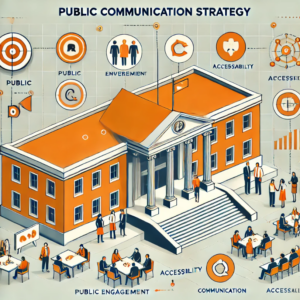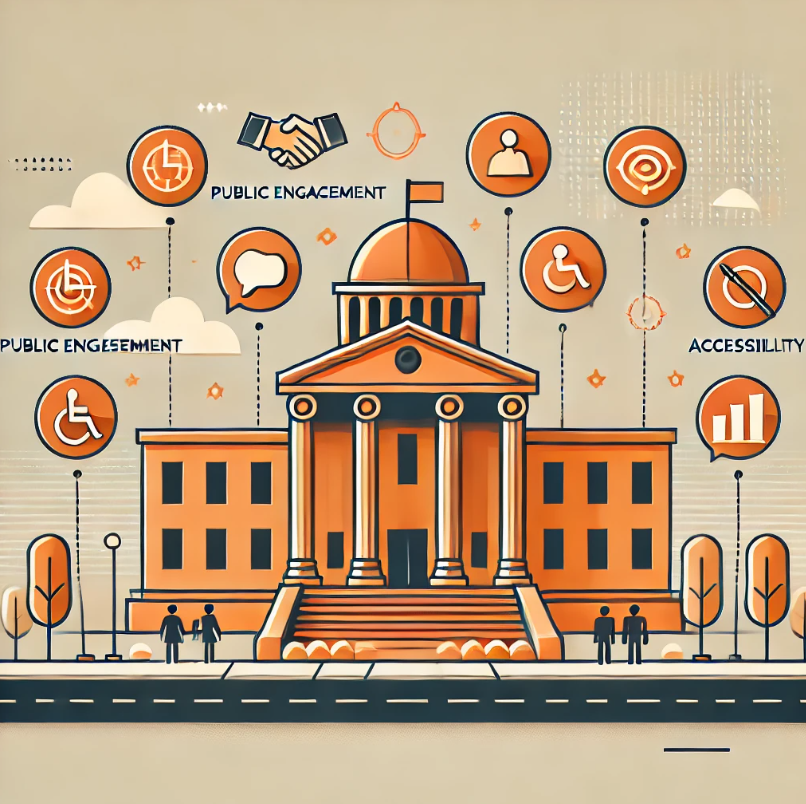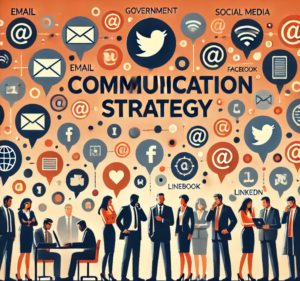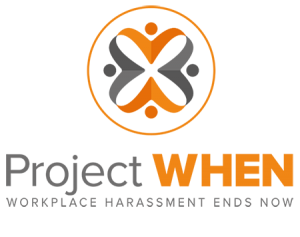Building a Strong Public Communication Framework for State and Local Government Agencies
 Effective public communication is at the heart of every successful state and local government agency. Whether sharing critical updates, engaging the community, or managing crises, the ability to deliver clear, timely, and inclusive messages is essential. In today’s fast-moving information landscape, where trust in government can be fragile, a strategic approach to public communication can make all the difference.
Effective public communication is at the heart of every successful state and local government agency. Whether sharing critical updates, engaging the community, or managing crises, the ability to deliver clear, timely, and inclusive messages is essential. In today’s fast-moving information landscape, where trust in government can be fragile, a strategic approach to public communication can make all the difference.
However, many agencies struggle with common pitfalls that can hinder their communication effectiveness. These challenges include failing to target messages to the right audiences, relying too heavily on outdated communication methods, and overlooking accessibility and inclusivity. Additionally, internal misalignment often results in inconsistent external messaging, which can cause confusion and reduce public trust. Addressing these issues requires a structured communication strategy that prioritizes clear messaging, stakeholder engagement, and the appropriate use of digital tools.
This blog explores how state and local government agencies can establish a strong communication framework to ensure clarity, transparency, and engagement across diverse communities.
1. Establishing a Clear Communication Strategy
A structured communication strategy ensures that every public message aligns with the agency’s goals, reaches the right audience, and fosters trust. The foundation of an effective strategy includes:
a. Defining Core Messages
What is Core Messaging?
Core messaging is the foundation of all public communications, summarizing the agency’s purpose, priorities, and key values. These messages should consistently appear in all external and internal communications to build recognition and trust with the public.
How to Build Core Messages
- Identify Key Priorities: Outline the primary goals and objectives of your agency.
- Make It Clear and Concise: Messages should be easy to understand and free of jargon.
- Ensure Consistency: All messaging should be aligned across different platforms, from press releases to social media.
- Test and Adapt: Regularly assess the effectiveness of messaging and adjust as needed based on feedback and engagement data.
b. Stakeholder Mapping
What is Stakeholder Mapping?
Stakeholder mapping is the process of identifying and categorizing different groups that an agency serves or interacts with. This helps tailor communication strategies to meet their unique needs.
How to Conduct Stakeholder Mapping
- Identify All Relevant Groups: Include residents, businesses, nonprofits, media, policymakers, peer agencies, and internal employees.
- Assess Their Interests and Concerns: Understand what information they need and how they prefer to receive it.
- Prioritize Engagement Strategies: Develop different communication approaches for various stakeholders based on their level of influence and involvement.
- Regularly Update Your Map: Stakeholder priorities may shift over time, so keep your mapping process dynamic.
c. Choosing the Right Communication Channels
Why Channel Selection Matters
Different groups consume information in different ways. Selecting the right channels ensures that your messages reach the intended audience effectively.
Best Practices for Selecting Communication Channels
- Understand Audience Preferences: Conduct surveys or analyze engagement data to determine where different groups get their information.
- Use a Multi-Channel Approach: Combine digital and traditional media, including social media, newsletters, press releases, and town hall meetings.
- Consider Accessibility: Ensure that all content is available in multiple formats, such as audio, print, and digital, to accommodate various needs.
- Monitor and Adjust: Continuously track engagement metrics to refine communication strategies over time.
2. Promoting Inclusive & Equitable Communication
Why Inclusivity Matters
State and local government agencies serve diverse populations. Ensuring that all groups can access and understand public communications is vital to fostering trust and participation.
How to Promote Inclusive Communication
a. Language Accessibility
- Provide Translations: Key documents, websites, and informational materials should be available in multiple languages relevant to the community.
- Use Professional Interpreters: Public meetings should offer real-time interpretation services to accommodate non-English speakers.
- Offer Multilingual Support Services: Call centers, online chats, and customer service desks should have language assistance available.
b. Cultural Sensitivity & Representation
- Use Inclusive Visuals and Stories: Communications should feature diverse individuals that represent the community’s demographics.
- Partner with Community Organizations: Collaborate with cultural groups and local organizations to ensure messaging resonates with different audiences.
- Avoid Assumptions and Biases: Messages should be crafted with cultural awareness, avoiding stereotypes and exclusionary language.
c. Accessibility Compliance
- Follow Digital Accessibility Standards: Ensure online content adheres to Web Content Accessibility Guidelines (WCAG) for people with disabilities.
- Provide Alternative Formats: Offer information in large print, braille, audio recordings, and accessible PDFs.
- Ensure Physical Accessibility: Public meetings and events should be held in ADA-compliant venues with sign language interpreters or captioning services available.
- Utilize Assistive Technologies: Provide tools such as text-to-speech software or screen readers to enhance access to digital information.
3. Internal vs. External Communications
The Importance of Internal Communication
Before announcing changes or new initiatives externally, agencies must first ensure internal alignment. Consistency in internal and external messaging builds credibility and confidence in leadership.
Best Practices for Internal Communication
- Keep Staff Informed Early: Employees should hear about key changes before the public.
- Encourage Two-Way Dialogue: Provide opportunities for staff to ask questions and share concerns.
- Ensure Message Consistency: Internal emails and briefings should reflect the same key messages being shared with the public.
Aligning Internal and External Communications
- Train employees to deliver accurate and consistent information to the public.
- Use internal feedback to refine external messaging.
- Ensure that frontline workers, who interact with residents daily, are equipped with up-to-date information.
Case Study: West Virginia State Parks
Even the best-intentioned communication strategies can fall short when agencies fail to plan effectively or adapt to public needs. The West Virginia State Parks system faced challenges in increasing park attendance and campground reservations but successfully turned things around with a strategic communication approach.
Challenges Faced by West Virginia State Parks
Before launching its successful campaign, the state park system struggled with:
- Lack of targeted messaging: Initial outreach efforts did not differentiate between local and out-of-state visitors, leading to ineffective communication.
- Complicated reservation systems: Visitors found it difficult to book campsites due to outdated online platforms.
- Limited engagement: The agency relied on traditional methods without leveraging digital tools, missing out on younger audiences.
Key Communication Solutions & Lessons for Other Agencies
West Virginia’s “Explore West Virginia State Parks” campaign tackled these issues through strategic communication efforts. Key takeaways include:
- Invest in High-Quality Digital Content: Visually engaging content captured audience attention and improved engagement.
- Improve Public Service Accessibility: A modernized reservation system enhanced the user experience.
- Leverage Community Partnerships: Collaborations with local businesses increased visibility and public trust.
- Encourage Year-Round Engagement: Seasonal events provided fresh reasons for visitors to return.
- Gather and Act on Public Feedback: Surveys and social media engagement helped refine communication strategies.
If you’re interested in learning more about West Virginia State Parks‘ successful communication campaign, you can read more here.
Conclusion
Public communication is more than just distributing information—it’s about fostering trust, engagement, and accessibility. By implementing a structured communication framework, state and local government agencies can strengthen their connection with communities, ensure transparency, and ultimately improve public services.
To support agencies in refining their approach, we’ve developed a Comprehensive Guide to Public Communications for State and Local Government Agencies, which outlines six critical components for effective communication:
-
Communication Strategy & Planning – Establishing a clear communication framework that defines core messaging, aligns internal and external communications, and ensures a structured approach to public outreach.
-
Platform & Infrastructure Build-Out – Developing the necessary digital and physical infrastructure to support effective communication, including websites, social media channels, and government service portals.
-
Content Planning & Scheduling – Creating a content roadmap to maintain consistency, tailor messaging for different audiences, and ensure timely delivery of key updates.
-
Content Development & Delivery – Crafting compelling, accessible, and engaging messages across multiple formats, from press releases and social media posts to public service announcements and interactive content.
-
Internal Communication Alignment – Ensuring that internal teams and stakeholders are informed, aligned, and prepared to support external messaging efforts, preventing inconsistencies and miscommunication.
-
Metrics & Key Performance Indicators (KPIs) – Establishing measurable goals and tracking engagement, audience reach, and impact to continuously refine and improve communication efforts.
Each of these elements plays a crucial role in strengthening government communications and ensuring that agencies can effectively connect with their communities. For a deeper dive into these strategies, including real-world case studies and actionable insights, read the full guide here.
Ready to Elevate Your Agency’s Public Communication?
We understand the unique challenges state and local government agencies face—from complex issues to diverse community needs. Our comprehensive approach can help you transform the way you connect with constituents, improve transparency, and highlight the valuable work your agency does every day.
Interested in learning more? Reach out to us today for a consultation. We’d love to discuss how our services can support your goals and help you build lasting trust with the communities you serve.





